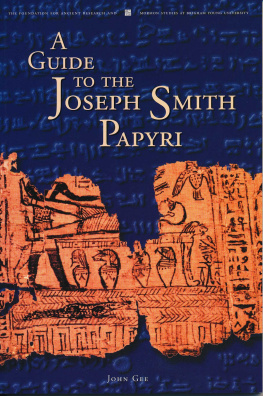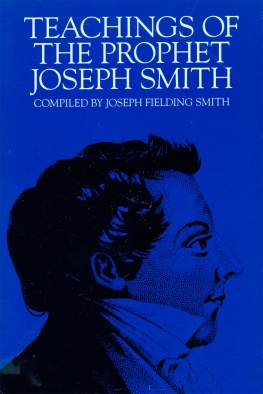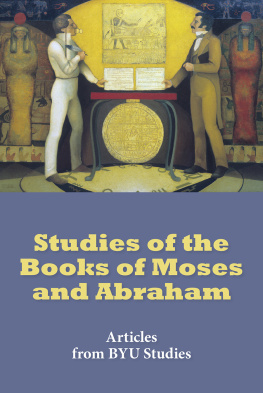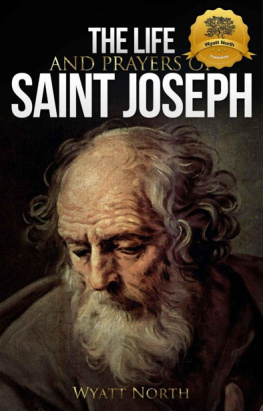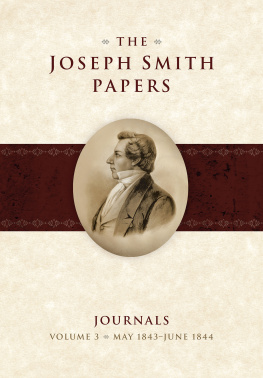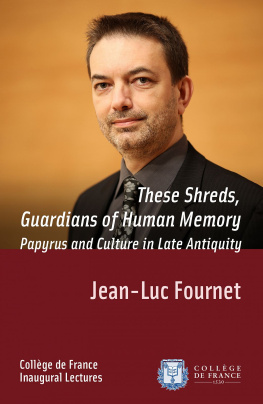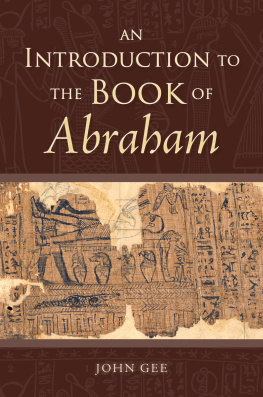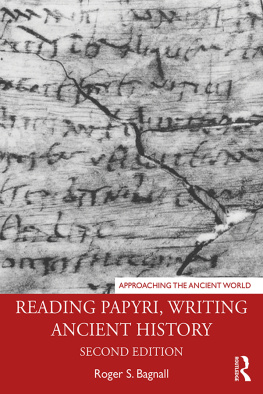John Gee - A Guide to the Joseph Smith Papyri
Here you can read online John Gee - A Guide to the Joseph Smith Papyri full text of the book (entire story) in english for free. Download pdf and epub, get meaning, cover and reviews about this ebook. year: 2000, publisher: Deseret Book Company, genre: Religion. Description of the work, (preface) as well as reviews are available. Best literature library LitArk.com created for fans of good reading and offers a wide selection of genres:
Romance novel
Science fiction
Adventure
Detective
Science
History
Home and family
Prose
Art
Politics
Computer
Non-fiction
Religion
Business
Children
Humor
Choose a favorite category and find really read worthwhile books. Enjoy immersion in the world of imagination, feel the emotions of the characters or learn something new for yourself, make an fascinating discovery.
A Guide to the Joseph Smith Papyri: summary, description and annotation
We offer to read an annotation, description, summary or preface (depends on what the author of the book "A Guide to the Joseph Smith Papyri" wrote himself). If you haven't found the necessary information about the book — write in the comments, we will try to find it.
Since the rediscovery of the Joseph Smith Papyri in 1967, the papyri have been the center of conflicting, and often confusing, claims.
Written by Egyptologist John Gee, this guide reflects not only the latest Egyptological research but also the most recent Latter-day Saint thought about the papyri.
A Guide to the Joseph Smith Papyri — read online for free the complete book (whole text) full work
Below is the text of the book, divided by pages. System saving the place of the last page read, allows you to conveniently read the book "A Guide to the Joseph Smith Papyri" online for free, without having to search again every time where you left off. Put a bookmark, and you can go to the page where you finished reading at any time.
Font size:
Interval:
Bookmark:

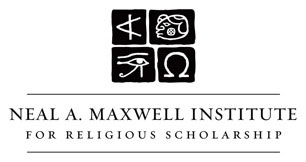
Foundation for Ancient Research and Mormon StudiesBrigham Young UniversityAll rights reservedPrinted in the United States of America
The views expressed in this article are the views of the author and do not necessarily represent the position of the Maxwell Institute, Brigham Young University, or The Church of Jesus Christ of Latter-day Saints.
Acknowledgements
This publication would not have been possible without the assistance of several individuals. Without the encouragement and support of M. Gerald Bradford, the director of research at the Foundation for Ancient Research and Mormon Studies, this publication would never have seen the light of day. Clark Gee, Brian M. Hauglid, Matthew Roper, Brian L. Smith, John A. Tvedtnes, and my wife, Kathleen, have provided important feedback. Wendy H. Christian, Alison V. P. Coutts, and Angela Clyde of the FARMS editorial staff have been unfailingly helpful in preparing the manuscript for publication. I would also like to thank Carmen Cole for helping make the charts readable; Julie A. Dozier, Paula W. Hicken, Linda M. Sheffield, and Sandra A. Thorne for proofreading the manuscript; Rebecca Sterrett for producing the maps; and Bjorn Pendleton for designing the volume. My sincere appreciation also goes to the Church of Jesus Christ of Latter-day Saints for permission to publish pictures of the Joseph Smith Papyri and the Kirtland Egyptian Papers, which reside in their archives, and to whom the intellectual property rights of these materials belong.
Introduction
More than a dozen years of answering questions about the Joseph Smith Papyri on a weekly, if not daily, basis have convinced me that one of the major problems with understanding the complicated issues surrounding the papyri has been the lack of up-to-date, reliable, readily available information on the Joseph Smith Papyri. Many discussions of the papyri are often completely devoid of not only recent Egyptological research but sometimes of even basic information about ancient Egypt. Additionally, few of the available discussions show any acquaintance with serious Latter-day Saint thought on either the Book of Abraham or the Joseph Smith Papyri. This guide has been prepared to provide basic information about the Joseph Smith Papyri and an overview of the discussion about the connections that they may have with the Book of Abraham for those who have no knowledge of ancient Egypt and perhaps little of the Latter-day Saints.
Due to the general nature of this work, references have been kept to an absolute minimum. I am currently preparing a larger study that will provide a fuller discussion with references.
The present work is not an official publication of the Church of Jesus Christ of Latter-day Saints and does not necessarily represent the official positions of the Church of Jesus Christ of Latter-day Saints, Brigham Young University, or the Foundation for Ancient Research and Mormon Studies at Brigham Young University.
Historical Overview
Early History of the Papyri
In the early part of the nineteenth century, Antonio Lebolo, an antiquities dealer working under the consul general of Egypt, plundered several tombs in Thebes in southern Egypt. Some of the antiquities he sold; others he kept. Among those he kept were eleven mummies that he brought home to Italy.
After Lebolo's death, his family sent the mummies through the shipping company of Albano Oblasser to sell in America to the highest bidder. The highest bidder was Michael Chandler, who, having failed to find valuables inside the mummies other than some papyri, took them around as part of a traveling curiosity show. After two years on the road, Chandler's mummy show reached Kirtland, Ohio, then the headquarters of the fledgling Church of Jesus Christ of Latter-day Saints.
Joseph Smith, prophet of the church, examined the several papyrus rolls and, after commencing "the translation of some of the characters or hieroglyphics," said that "one of the rolls contained the writings of Abraham, another the writings of Joseph of Egypt, etc." (see charts on pages 1013).
History of the Translation of the Book of Abraham
Joseph Smith began translating the papyri in early July 1835. The current text of the Book of Abraham was translated by the end of the month. He left off translation in August 1835 to visit the Saints in Michigan. Translation continued through 25 November 1835, but Joseph then set aside the papyri to study Hebrew, finish the Kirtland temple and dedicate it, and, later, deal with troubles in Missouri. While Joseph slightly revised the translation preparatory to its publication in 1842, there is no other evidence that he worked on the translation of the existing Book of Abraham after 1835 (see chart on opposite page).
We have no firsthand evidence that Joseph Smith used the Urim and Thummim or a seer stone in translating the Book of Abraham. Nor did Joseph apparently use any grammars or dictionaries in preparing his translations. Joseph Smith himself never discussed how he translated the Book of Abraham. Nevertheless, Warren Parrish, one of the scribes involved in the translation during late 1835, stated, "I have set [sic] by his side and penned down the translation of the Egyptian Hiero-glyphicks [sic] as he claimed to receive it by direct inspiration of Heaven."
History of the Publication of the Book of Abraham
In early 1842 Joseph Smith, Willard Richards, and Reuben Hedlock prepared the text for publication in the Times and Seasons. Only three installments were published, which included about one quarter of what Joseph Smith translated. Unfortunately the location of the original manuscripts of his translation is presently unknown and thus about three quarters of Joseph Smith's translation of the Book of Abraham is lost. The three facsimiles made to accompany the translation of the Book of Abraham were cut to actual size by Reuben Hedlock.
In 1851 Franklin D. Richards, then the newest apostle of the church and the new president of the European Mission headquartered in England, found that the church members in Englandthe location with the largest concentration of Latter-day Saints in the world at the timehad almost no church literature. Elder Richards included the Book of Abraham in "a choice selection from the revelations, translations, and narrations of Joseph Smith," published as The Pearl of Great Price. The facsimiles of the Book of Abraham were recut with this edition and succeeding editions, becoming increasingly more inaccurate with subsequent editions.
In 1878 the Pearl of Great Price was published in Utah. Two years later it was canonized by a vote of the general conference. The longest-used edition was published in 1907; it had the most inaccurate copies of the facsimiles and continued to be used until the 1981 English edition restored Hedlock's original facsimiles. The 1981 edition has been the standard edition ever since (see chart on opposite page).
Later History of the Papyri
When Joseph Smith bought the papyri, the outer ends of the papyrus scrolls were already damaged. To prevent further damage, the outside portions of some of the papyri were separated from their rolls, mounted on paper, and placed in glass frames. The remainder of the rolls were kept intact.
In Nauvoo Joseph Smith turned over the mummies and papyri to his mother, Lucy Mack Smith, to free himself from the obligation of exhibiting the papyri and to provide his widowed mother with means to support herself. She kept the mummies and papyri for the rest of her life, exhibiting them to interested visitors for twenty-five cents a person. On 26 May 1856, less than two weeks after Mother Smith died, Emma Smith (Joseph's widow), her second husband, Lewis C. Bidamon, and her son, Joseph Smith III, sold the mummies and the papyri to Abel Combs.
Font size:
Interval:
Bookmark:
Similar books «A Guide to the Joseph Smith Papyri»
Look at similar books to A Guide to the Joseph Smith Papyri. We have selected literature similar in name and meaning in the hope of providing readers with more options to find new, interesting, not yet read works.
Discussion, reviews of the book A Guide to the Joseph Smith Papyri and just readers' own opinions. Leave your comments, write what you think about the work, its meaning or the main characters. Specify what exactly you liked and what you didn't like, and why you think so.

